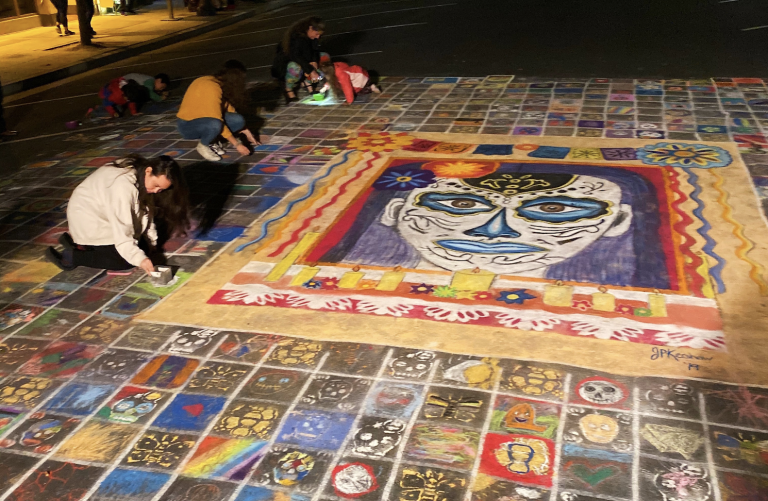Amid colorful decorations, holiday lights and cheerful melodies, many families enjoyed Mexican traditions with vitality. Two Sundays ago, my Spanish class celebrated Día de los Muertos in downtown Redwood City. Courthouse Square was lively with visitors relishing Mexican music, dance, crafts and delicious food. It was the perfect way to end Halloweekend, celebrating the circle of life and cultural heritage.
Professor Alice Miano’s SPANLANG 11SL: “Second-Year Spanish: Emphasis on Service Learning” class focuses on understanding the art and culture of immigrant communities, particularly in Redwood City, where we work weekly with middle schoolers at the Boys and Girls Club. I’ve learned so much about the vibrancy of the Latin American communities surrounding us, including in San Francisco. As well, we visited the SF Mission District a few weeks ago, analyzing countless murals that comment on the experiences of immigrant families like those in Redwood City. By learning about and visiting these communities, we escape the Stanford bubble and feel connected to a different community.
After the short 20-minute drive to Redwood City, we were welcomed by the hum of upbeat instrumentals and a community street mural, where anyone could add their chalk drawings in squares surrounding a larger, exquisitely executed skull depiction.
My classmates and I added our unique drawings to the masterpiece at the end of the night, leaving our mark on the festival.
Continuing through the streets, we were increasingly surrounded by spirited traditions. To celebrate and honor the lives of relatives who have passed, families create ofrendas — altars containing offerings that encourage their souls to visit. These altars were filled with photos of the departed loved ones, their favorite foods and cempasuchiles — Mexican marigolds which, by their bright color and strong scent, help guide the dead, while symbolizing the truth in their roots.
We came across a tiendita offering decorate-your-own calaveras de azucar — sugar skulls — a fun way to take a piece of the celebration home. These sugar skulls are an iconic symbol of Día de los Muertos and Mexican culture generally. To form the base, sugar and water are boiled and poured into skull molds of all sizes, which dry and solidify with a wax-like look. The best part, which many children were doing intently with wide eyes, was colorfully decorating them with icing. Many other little shops lined the streets, selling clothing, jewelry, toys and other trinkets.
We can’t forget about the food! I had un tamal de rajas y queso — a chili and cheese tamale — that hit the spot after a long day of catching up on homework. The pico de gallo and red salsa on top were delicious; I had been missing real Mexican food. We also had to try some boiling hot champurrado, which is thick Mexican hot chocolate made with corn flour. It was an interesting variation on typical hot cocoa, and it definitely kept us warm and full for the rest of the night. Other comidas included burritos, deep fried vegetables, pan dulce (sweet bread) and, of course, churros.
Accompanying all of this was exuberant music played by bands of varying origins. We noticed the differences between Mexican and Puerto Rican music while dancing along, enjoying each other’s company and the dynamic community around us.
For me, this evening was a refreshing taste of my home in New Mexico. I grew up in a similar culture woven with Mexican and Native American traditions, and I appreciated cultural events like this as a child. It’s comforting to know that these customs are alive so close to campus, and I would recommend that others learn about and experience these types of celebrations. It was a truly wonderful experience, and I’m grateful that Professor Alice Miano provided this opportunity for us!
Contact Maria Metzger at mcmetz ‘at’ stanford.edu.
